 Robert Pepper
Robert Pepper
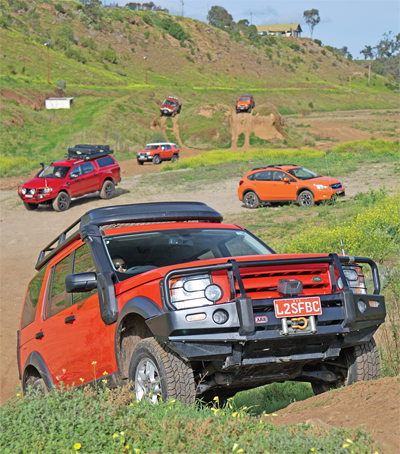 Perhaps the most commonly discussed topic in Discovery circles is that of tyres, and on that front I have news. Back in the April 2013 edition I reported that the D3’s BFGoodrich KM2 mud tyres had worn out, and I was replacing them with the least aggressive tyre I’ve ever owned on a 4×4; Cooper AT3s. The logic behind this was simple; after years of driving stock-standard press cars with standard tyres I’ve still managed to have a lot of fun and get pretty much anywhere I want to go. This is because over time vehicles are becoming more capable, with ever-more effective traction control, power delivery and suspension. Even today, my 2008 Discovery 3 can hold its head high, and while it is modified the mods are all about touring, not off-road capability. Tyre technology has also progressed, with punctures becoming so rare road cars are omitting spare tyres entirely, and traction has improved across all surfaces. Yet for all that progress punctures are still entirely possible and in the ongoing war of sharp mallee roots against tyres it is fair to say nature is still well head.
Perhaps the most commonly discussed topic in Discovery circles is that of tyres, and on that front I have news. Back in the April 2013 edition I reported that the D3’s BFGoodrich KM2 mud tyres had worn out, and I was replacing them with the least aggressive tyre I’ve ever owned on a 4×4; Cooper AT3s. The logic behind this was simple; after years of driving stock-standard press cars with standard tyres I’ve still managed to have a lot of fun and get pretty much anywhere I want to go. This is because over time vehicles are becoming more capable, with ever-more effective traction control, power delivery and suspension. Even today, my 2008 Discovery 3 can hold its head high, and while it is modified the mods are all about touring, not off-road capability. Tyre technology has also progressed, with punctures becoming so rare road cars are omitting spare tyres entirely, and traction has improved across all surfaces. Yet for all that progress punctures are still entirely possible and in the ongoing war of sharp mallee roots against tyres it is fair to say nature is still well head.

 Bob Cooke – contributor
Bob Cooke – contributor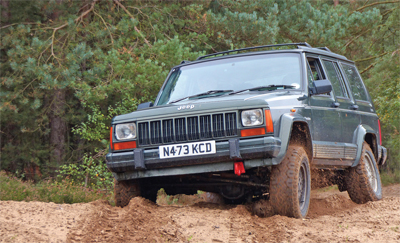 Ignominy. The dictionary defines it as a feeling of disgrace, public shame. That’s exactly how I felt; though at least there wasn’t any public around when it happened. Being a reasonably experienced and competent off-road driver, I’m usually quite good at reading the way ahead and deciding whether or not the Cherokee will get through. There is the argument that even if the way ahead looks doubtful the whole idea of having some off-road fun is to have a go, and no shame attached if you don’t make it, getting stuck does, after all, provide an excellent opportunity to exercise your recovery skills.
Ignominy. The dictionary defines it as a feeling of disgrace, public shame. That’s exactly how I felt; though at least there wasn’t any public around when it happened. Being a reasonably experienced and competent off-road driver, I’m usually quite good at reading the way ahead and deciding whether or not the Cherokee will get through. There is the argument that even if the way ahead looks doubtful the whole idea of having some off-road fun is to have a go, and no shame attached if you don’t make it, getting stuck does, after all, provide an excellent opportunity to exercise your recovery skills. 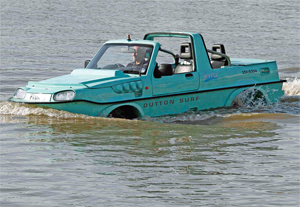 As we all know, 4x4s come in all shapes and sizes, but few can actually float. We meet with Tim Dutton, an endearing character, and founding father of the this country’s kit car industry, with his latest 4×4 creation. Let’s go off-road Surf-ing in the UK…
As we all know, 4x4s come in all shapes and sizes, but few can actually float. We meet with Tim Dutton, an endearing character, and founding father of the this country’s kit car industry, with his latest 4×4 creation. Let’s go off-road Surf-ing in the UK… 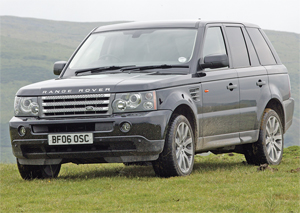 When the all-new Range Rover of 2002 appeared it was a stunning departure from the original concept. Gone was the separate steel chassis, gone were the beam axles, and gone was the trusty old Buick V8 engine. With its all-independent suspension and sleek new styling it was the starkest indication yet that the Range Rover was no longer the estate manager’s town car, it was intended to be one of the world’s best luxury limousines with four-wheel drive, almost an incidental fop to the growing interest in all-wheel drive SUVs. The transformation was fuelled by financial and technical input from BMW and Ford, which had sequentially owned the Land Rover brand at that time; hence there was also a quantum leap in the build quality and the promise of better performance, economy and reliability from new engines and transmissions.
When the all-new Range Rover of 2002 appeared it was a stunning departure from the original concept. Gone was the separate steel chassis, gone were the beam axles, and gone was the trusty old Buick V8 engine. With its all-independent suspension and sleek new styling it was the starkest indication yet that the Range Rover was no longer the estate manager’s town car, it was intended to be one of the world’s best luxury limousines with four-wheel drive, almost an incidental fop to the growing interest in all-wheel drive SUVs. The transformation was fuelled by financial and technical input from BMW and Ford, which had sequentially owned the Land Rover brand at that time; hence there was also a quantum leap in the build quality and the promise of better performance, economy and reliability from new engines and transmissions.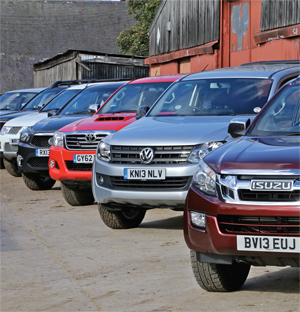 After our annual 4×4 Of The Year test in the last issue, we turn our attention to the pick-up market. With models from China, Korea, Japan (and Japan via the USA) this is a small, but highly competitive selection of 4x4s, and it’s a market enjoying some growth. From the adjoining table, you can see that since 2009, UK pick-up registrations have risen significantly, and this year looks like being particularly strong. Now all these pick-ups have important characteristics in common; all diesel powered, all double cab, and all but one with selectable 4WD. They do, however, have very different characteristics and achieve the common aim of carrying four passengers, significant payload, and being able to tow, in very different ways. Prices too, vary widely. We have reported the manufacturer’s claimed basic prices, which all exclude VAT (since in most cases, this is reclaimable), and that means the most expensive model here, the VW Amarok, is close to twice the cost of the cheapest, the Great Wall Steed. For vehicles that are so matched in their main raison d’etre, this is a significant difference. Is it worth that extra expense?
After our annual 4×4 Of The Year test in the last issue, we turn our attention to the pick-up market. With models from China, Korea, Japan (and Japan via the USA) this is a small, but highly competitive selection of 4x4s, and it’s a market enjoying some growth. From the adjoining table, you can see that since 2009, UK pick-up registrations have risen significantly, and this year looks like being particularly strong. Now all these pick-ups have important characteristics in common; all diesel powered, all double cab, and all but one with selectable 4WD. They do, however, have very different characteristics and achieve the common aim of carrying four passengers, significant payload, and being able to tow, in very different ways. Prices too, vary widely. We have reported the manufacturer’s claimed basic prices, which all exclude VAT (since in most cases, this is reclaimable), and that means the most expensive model here, the VW Amarok, is close to twice the cost of the cheapest, the Great Wall Steed. For vehicles that are so matched in their main raison d’etre, this is a significant difference. Is it worth that extra expense?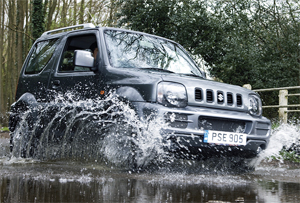 Oh, sure, we laughed at the Jimny when it appeared in 1998, far too small to be a useful SUV, too puny and low-slung to be a competent off-roader, surely it was nothing more than a nippy, traffic-dodging, easy-park city car, a little kinky in the styling department but hardly more desirable than a Mini…
Oh, sure, we laughed at the Jimny when it appeared in 1998, far too small to be a useful SUV, too puny and low-slung to be a competent off-roader, surely it was nothing more than a nippy, traffic-dodging, easy-park city car, a little kinky in the styling department but hardly more desirable than a Mini… Bob Cooke – contributor
Bob Cooke – contributor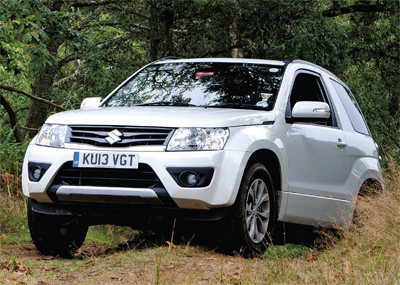 It wasn’t all that long ago that the name ‘rhino’ was pretty much synonymous with ‘Suzuki’ – the all-conquering little SJ made the rhino symbol its own, a fitting reference to the little Suzuki’s rugged and adventurous nature. It seemed fitting, therefore, that we should involve our long-term Grand Vitara in a more recent rhino-related event, a tough off-road challenge aimed at raising money for conservation projects in Africa.
It wasn’t all that long ago that the name ‘rhino’ was pretty much synonymous with ‘Suzuki’ – the all-conquering little SJ made the rhino symbol its own, a fitting reference to the little Suzuki’s rugged and adventurous nature. It seemed fitting, therefore, that we should involve our long-term Grand Vitara in a more recent rhino-related event, a tough off-road challenge aimed at raising money for conservation projects in Africa. 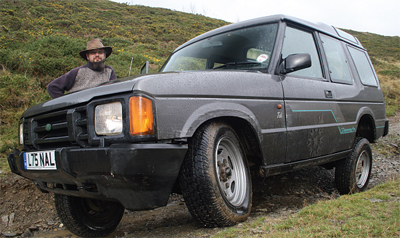 Not everything has gone to plan lately. I spent a week preparing the car and loading it up for a green lane session in North Yorkshire with some friends. Having not done very much laning at all outside Wales, I was looking forward to a change of scenery. Sadly, only three miles into the 160-mile journey there, it all went wrong. There was a clank, a bang and the front left wheel locked up. Fortunately, it was wet and the wheel was on a white line at the time, so I slowed down with rather less drama than I might have. Reversing freed off the wheel and I could limp home. I hurled everything into the Volkswagen Golf Mk2 I owned at the time and headed north, feeling somewhat depressed.
Not everything has gone to plan lately. I spent a week preparing the car and loading it up for a green lane session in North Yorkshire with some friends. Having not done very much laning at all outside Wales, I was looking forward to a change of scenery. Sadly, only three miles into the 160-mile journey there, it all went wrong. There was a clank, a bang and the front left wheel locked up. Fortunately, it was wet and the wheel was on a white line at the time, so I slowed down with rather less drama than I might have. Reversing freed off the wheel and I could limp home. I hurled everything into the Volkswagen Golf Mk2 I owned at the time and headed north, feeling somewhat depressed.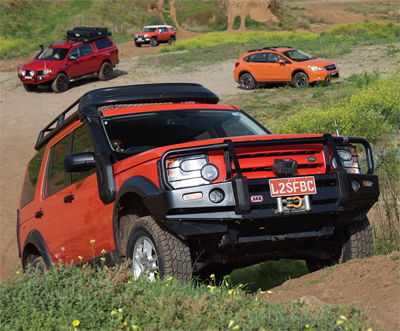 Every so often your brakes will wear out, and as is usual with any vehicle component the extra stress of off-roading means more frequent replacements. Brakes are no exception, as a touring off-road weighs more than a standard car, and then you’ve got grit and mud getting in the discs as well as extra use downhill. Traction control also wears a little, although that has much less effect on brake wear than might be thought. This is because when a spinning wheel is braked to transfer torque to the other wheel on the axle there’s little force required to slow the spinning wheel – unlike the force required to brake a two or three tonne 4×4.
Every so often your brakes will wear out, and as is usual with any vehicle component the extra stress of off-roading means more frequent replacements. Brakes are no exception, as a touring off-road weighs more than a standard car, and then you’ve got grit and mud getting in the discs as well as extra use downhill. Traction control also wears a little, although that has much less effect on brake wear than might be thought. This is because when a spinning wheel is braked to transfer torque to the other wheel on the axle there’s little force required to slow the spinning wheel – unlike the force required to brake a two or three tonne 4×4. It was somewhat appropriate that I drove our Toyota RAV4 to the dealer on what was obviously the coldest day of the winter so far. The temperature gauge actually said 2degC, but standing scrapping the ice from the windscreen, it certainly seemed a lot colder than that.
It was somewhat appropriate that I drove our Toyota RAV4 to the dealer on what was obviously the coldest day of the winter so far. The temperature gauge actually said 2degC, but standing scrapping the ice from the windscreen, it certainly seemed a lot colder than that.